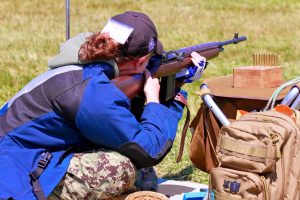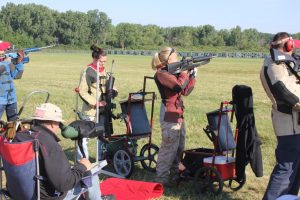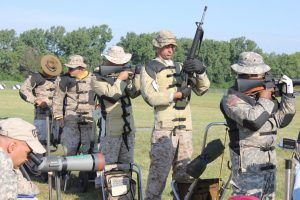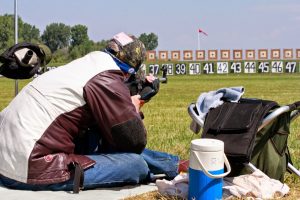High Power Rifle Competitions — Going the Distance
High Power Rifle competition is one of the most traditional and popular of the shooting sports. It is not merely challenging, it is a historical sport, harkening back to the very origins of civilian marksmanship training and the National Rifle Association (NRA).
NRA and the Civilian Marksmanship Program (CMP) are the two governing bodies of the sport of High Power. NRA was founded following the Civil War in order to promote the marksmanship training of civilians after the shooting performance of wartime conscripts proved woefully inadequate. The CMP was chartered by the U.S. government following its adoption of the 1903 Springfield Rifle shortly after the turn of the 20th century.
At the time, civilians were most familiar with lever-actions, not Mauser-type bolt-action rifles, so the government created what was then called the Director of Civilian Marksmanship (DCM) to ensure an adequate pool of potential soldiers who were familiar with the new rifle style. One of the ways CMP did this was to issue or sell surplus rifles, usually through DCM-affiliated clubs. The structure of DCM was revised in the early 1990s, when it was renamed the Civilian Marksmanship Program, and though it is now a non-profit organization, it still retains many of its original functions; High Power Rifle competition maintains and fulfills the goals of both NRA and CMP by making sure that the citizenry is both proficient at marksmanship and safe in the handling of arms suitable for defense of state and nation. The sport itself further promotes discipline, friendly competition, camaraderie and personal growth.
How Does High Power Competition Work?
To compete in High Power Rifle, competitors engage targets at various predetermined distances, from specified shooting positions, and within specified time constraints. The guns themselves are distinguished and categorized by specific features, so shooters are competing only against those firing similar rifles. There are several rifle categories and each has a rather extensive description of allowed features.
The Rifles
Broadly speaking, the guns are divided into two classes: Service Rifle and Match Rifle. A service rifle is a gun as similar as possible to a U.S.-issued service rifle. Today that includes the M1 Garand, M14 and M16. Of course, in the case of the latter two, that also means the Springfield M1A and the AR-15 rifles, as they are the semi-automatic versions of the selective-fire (full-auto capable) military-issued M14 and M16, respectively. In addition, the SR-25, a rifle based on the military’s M110, has also recently been added to the list of rifles Service Rifle competitors may use. Iron sights are traditionally and most commonly used, though in competition they can be more finely calibrated than those typical on a military-issue rifle.
A match rifle is one that has been “tricked out.” It can and often is based on an AR-15 action, but doesn’t have to be. A match rifle will commonly have a custom stock, custom barrel, custom sights, etc. It can be of any caliber below .35. As you can well imagine, a match rifle can be very expensive, depending on the number of custom components and how much careful gunsmithing it receives.
While Service Rifle and Match Rifle are the two broad categories of guns in High Power Rifle competition, demand has expanded options. Depending on the anticipated interest, there may be matches for service rifles with optical sights, military rifles issued by foreign governments, and hunting rifles and others limited only by caliber (below .35).
The Course of Fire
The complete, prescribed course of fire for High Power Rifle competition consists of the following:
- Slow Fire, standing — 10 rounds at 200 yards in 10 minutes.
- Rapid Fire, sitting or kneeling — 10 rounds at 200 yards in 60 seconds.
- Rapid Fire, prone — 10 rounds prone at 300 yards in 70 seconds.
- Slow Fire, prone — 10 rounds prone at 500 or 600 yards in 10 minutes.
This is referred to as a “Full Course” match. Because it is both time consuming and requiring of a very large range, Full Course matches are often eschewed in favor of “Reduced Range” competitions. For instance, local matches on ranges that can’t accommodate longer distances may restrict their matches to one stage, with everyone firing from the prone position. Also, reduced-size targets are often employed at smaller ranges, to simulate shooting at more distant targets.
Gear
As with any hobby, you can spend as much or as little as you choose. The cheapest, easiest entrée into High Power Rifle is to see what guns you already have and if any of them fit into a particular category or can be made to fit a category with the removal of a feature or two and (often) the installation of rule-compliant iron sights. If you don’t own an appropriate gun but would like a no-hassle way to get started in the sport, opt for the Service Rifle category. Many of the major manufacturers of AR-type rifles offer versions expressly equipped for High Power Rifle competition. When looking to purchase one of these, though, be careful that the “match-ready” gun you select is built for High Power Rifle, not the increasingly popular but very different sport of 3-Gun.
You’ll also need ammunition, of course, and eye and hearing protection. Additionally, a sling, either leather or web, is required. A logbook and pen to record your shots, the shooting conditions (temperature, wind, etc.) and your progress can also be very beneficial. The final mandatory piece of gear is a yellow plastic flag device known as an “empty chamber Indicator.” This device is inserted in the chamber any time you are not actively shooting and tells others that your gun is empty and the bolt open.
Most High Power Rifle competitors find it very helpful to have a spotting scope, but a serviceable binocular will do nicely until you decide whether to take a bigger financial plunge. If you do, then you can also add a shooting mat (an old carpet remnant or rain slicker will do until you want to make an investment in a high-end mat). A thick, fingerless, padded glove, a specialized shooting jacket with padded pressure points, and maybe an anemometer to gauge the wind, will be on your list of eventual purchases, too.
Why Do It?
High Power Rifle competition, like practically all shooting disciplines, fosters camaraderie and cooperation — but even more so. Competitors routinely fire in squads and take their turn in “the pits.” The pits are the ditches holding the targets, which are raised when shooting time commences during a stage and then lowered for scoring when that stage’s allotted time is up. All that target changing and scoring is done by squads of shooters rotating out of shooting positions and taking their turn in the pits. It’s that element of teamwork that really adds a powerful element to the sport.
High Power Rifle is a very old and established sport with decades of codified procedures to ensure a safe, engaging and enjoyable time for everyone. Study the very thorough and detailed rulebooks, gradually upgrade your gear and — when needed — seek advice from experienced shooters, and you can look forward to enjoying a life-long pursuit. For more information visit CMP at www.cmp.org, and NRA’s competition page at www.compete.nra.org.




